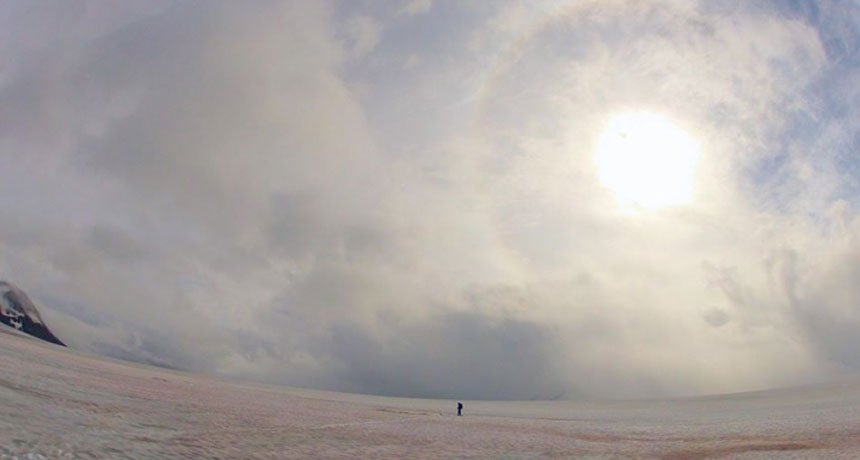Now we know how much glacial melting ‘watermelon snow’ can cause

Microbes are pushing glacial snow into the red.
An alga species that grows on glaciers gives the snow a crimson hue, which increases the amount of sunlight that the snow soaks up and makes it melt faster, new measurements confirm. On Alaska’s Harding Icefield, these microbes are responsible for about a sixth of the snowmelt in algae-tinged areas, researchers report September 18 in Nature Geoscience. The finding suggests that future climate simulations, unlike current ones, should account for the effects of these algae when making predictions about glacial melt.
The pink color, sometimes called watermelon snow, is caused by Chlamydomonas nivalis algae and related species. C. nivalis thrives in cold water, and “snowfields and glaciers are, in some sense, an aquatic environment,” says study coauthor Roman Dial, a biologist at Alaska Pacific University in Anchorage. Blooms pop up in the spring and summer, but the algae can come back year after year. Recent research has suggested that darkening of the snow by these algae or other microbes might make it melt faster. That melt might spur even more algal growth, starting a feedback loop of accelerated melting, scientists have proposed. But this is the first time algae’s effect on snowmelt has been directly tested.
“We used everything from microscopes to satellites,” Dial says.
Glaciers naturally contain small amounts of nutrients like nitrogen and phosphorus, and higher levels of those nutrients might spur algal growth. So Dial and colleagues added either extra water or nutrient-rich fertilizer to different patches of snow on Harding Icefield, a 1,900-square-kilometer frozen expanse in southern Alaska. More water led to the growth of 50 percent more algae compared with algal growth in untouched regions, the team found. Adding fertilizer quadrupled algal growth.
Then, in new test sites, the researchers added algae to some areas by dousing spots in fertilizer and removed algae from other sites using bleach. Over 100 days, the scientists tracked how much the zones melted. Places with extra algae melted much faster than areas where algae had been stripped away — they were three times as likely to melt down to slush or exposed ice by the end of the test. Exposing ice could amplify the algae’s melting effects because bare ice reflects less (and absorbs more) sunlight than clean snow.
Using satellite imagery and remote sensing equipment, the team then estimated the impact that algae have on snowmelt across the entire Harding Icefield. Algae grew on more than a third of the sheet. Within that 700-square-kilometer area, the microbes were responsible for about 17 percent of the snowmelt, the team concluded. Most of the rest of the melting was caused by warm temperatures.
“There’s a growing push to understand the impact of microorganisms on glaciers and ice sheets,” says Christopher Williamson, a microbiologist at the University of Bristol in England who wasn’t part of the study. Scientists often rely on long-term observations for these types of studies, Williamson says, but this research manipulates the environment to show a direct connection between algal growth and snowmelt.
The effect probably isn’t limited to Alaska, either. A different team sampled red snow from across the Arctic and found that its presence decreased snow reflectivity by 13 percent, according to research published last year in Nature Communications. Lower reflectivity would likely increase the snow’s melt rate because it means more sunlight gets absorbed, though that wasn’t directly shown. And if warming Arctic temperatures increase the area of snow algae’s preferred habitat of just-below-freezing snow, the microbes might expand their range further.
Other microbes or contaminants might also hasten glacial melt. Williamson is part of a five-year project investigating the impact of ice algae, which is different than snow algae, and bacteria on the Greenland ice sheet (SN: 5/20/00, p. 328). He and colleagues want to figure out whether the dark tinge on the ice from those microbial residents helps explain why the ice sheet is melting faster than expected from climate change alone.